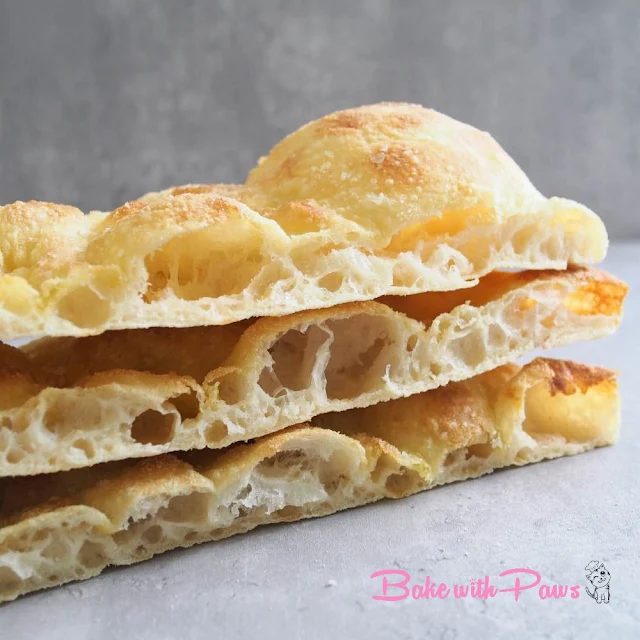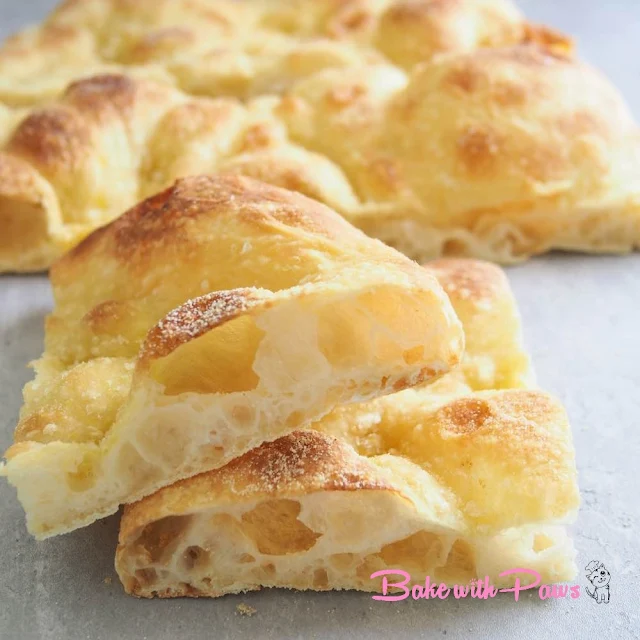Breads (Sourdough) - Open Crumb
Pala Romana (Sourdough)
April 19, 2024
| Recipe by Bake with Paws
Scroll to the bottom of the page for "PRINT RECIPE" ⬇
Pala Romana" pizza refers to a specific style of pizza that originated in Rome, Italy. Unlike the more famous Neapolitan pizza, which is round and often cooked in a wood-fired oven, Pala Romana pizza is rectangular and typically baked in an electric or gas oven. Here are some key characteristics of Pala Romana pizza:
Rectangular Shape: Pala Romana pizza is long and rectangular in shape, similar to a baking sheet or a cutting board. This distinguishes it from the round shape of Neapolitan pizza.
Thicker Crust: The crust of Pala Romana pizza is thicker compared to Neapolitan pizza. It has a light and airy texture, and the dough is often allowed to rise for an extended period, resulting in a fluffy yet slightly chewy crust.
Toppings: Similar to other Italian pizzas, Pala Romana pizza can be topped with a variety of ingredients. Classic toppings include tomato sauce, mozzarella cheese, fresh vegetables, cured meats like prosciutto or salami, and herbs such as basil or oregano.
Baking Method: While Neapolitan pizza is traditionally cooked in a wood-fired oven at very high temperatures for a short time, Pala Romana pizza is typically baked in an electric or gas oven at lower temperatures for a longer duration. This slower baking process allows the thicker crust to cook through evenly without burning.
Serving Style: Due to its rectangular shape, Pala Romana pizza is often sliced into smaller, square or rectangular pieces. It is a popular choice for sharing among a group of people or as a snack or meal in casual dining settings.
How To Store:
If you're not planning to eat it right away, allow the pizza to cool completely. Then, wrap it tightly with plastic wrap and store it in the refrigerator for up to 2-3 days until you're ready to enjoy it.
When ready to eat, reheat the pizza in a preheated oven until the crust is crisp and the toppings are heated through. Enjoy your delicious Pala Romana pizza!
If you have any questions regarding this recipe or any other post, please leave me a comment in the “LEAVE A COMMENT” link and I will reply you as soon as possible. Do tag me on Instagram @Bakewithpaws if you attempt on this recipe.
How To Make Pala Romana
Yields: 1
INGREDIENTS:
300g bread flour (I used Japanese high gluten flour) - 100%
75g active sourdough starter (100% hydration) - 25%
233g water - 80%
6g sea salt - 2%
15g olive oil
METHOD:
- Levain:
- Feed ratio of 1:1:1, keep at room temperature (28C – 29C) and wait until tripled, around 3 – 4 hours. Please feed your starter at the ratio that fit your schedule as long as the starter is at its peak when use.
- Mixing the dough:
- Dissolve levain and water in a bowl of stand mixer. Add in olive oil, salt and flour. Mix with paddle attachment for about 3 - 4 minutes at speed 2 (KA mixer) and slowly turn to speed 4 or until the dough turns smooth, comes together and away from the sides of the bowl. Transfer the dough into a greased bulking dish. Cover and rest for 30 minutes.
- Coild Fold (At Room Temperature 27C):
- Coild Fold 1 – Fold in the dish. Cover and rest for about 45 - 60 minutes.
- Coild Fold 2 – Repeat the same. Cover and rest for about 60 minutes.
- Coil Fold 3 – Repeat the same. Cover and rest for about 60 - 90 minutes or until dough rise 50 - 60% in size.
- Cold Retard
- Cover and let it retard overnight in the fridge (4C) for 12 - 16 hours. This bread was about 15 hours
- Shaping: (Next Morning around 9.30 am)
- Remove dough from the fridge. Invert it onto a floured counter top.
- Flip the dough back (smooth side is facing up) and transfer to a tray dusted with semolina flour.
- Stretch it out a bit and let the dough proof for about 2 - 3 hours (28C room temperature) or until the dough puff up.
- Baking -
- Preheat oven with baking stone at 250C (top and bottom heat) for 30 minutes before baking. I placed the rack on the 2nd position from the bottom.
- After about 2 hours of proofing, the dough would have risen and puffed up. Stretch the dough and firmly press your fingers into it to create dimples then transfer it onto a pizza scrapper. Drizzle some olive oil and sprinkle salt on top.
- Open the oven door, slide dough on baking stone.
- Bake at preheated oven for about 12 minutes or until golden brown.
- Once cooked, remove from the oven and let it cool a little and dressing with the toppings you like. You can also let it cool completely and wrap tightly with plastic wrap and store in the refrigerator to use later up to 2 - 3 days.
GENERAL NOTES
SOURDOUGH STARTER
Please click this link for "How To Make Sourdough Starter" and "Sourdough Maintenance"
A healthy starter is very crucial as advised by Baking with Gina. It is advisable to feed your starter regularly if you want your bread to rise nicely and to use the starter (levain) at its peak. A starter that is fed regularly will be more active in general. If the mother starter is not strong, the bread dough will not rise a lot even though the starter is used at its peak.
HYDRATION
The liquid measurement given is also a guide. It is advisable to always reserve some liquid and not add it all in one go. This would give you the opportunity to adjust if necessary. If dough is too dry, add the reserve liquid one tablespoon at a time until the right consistency. This is because each flour absorbs water and hydrates differently.
BULK FERMENTATION
Bulk fermentation starts when you add in levain to the dough and ends when the dough is ready for shaping.
TEMPERATURE DURING BULK FERMENTATION
Ambient temperature plays a very important part in sourdough baking. It will affect the dough temperature and eventually affect your fermentation time. The cooler ambient temperature will extend the fermentation time. The greater degree of proof, the stronger the dough will be as explained by Trevor J. Wilson.
The ambient temperature that worked for me is between 25C - 26C and bulk fermentation time is between 4.5 hours to 5.5 hours. At the end of bulk fermentation, my dough would have increased 50% in volume. The dough should look puffy. It should jiggling when you slightly shake it. This is the end of bulk fermentation.
But, my kitchen ambient temperature (without air-conditioner) was 29C - 30C. So, I have to bring down the temperature.
How to bring down ambient temperature?
- Air-conditioner room - Rest the dough in air-conditioner room during bulk fermentation. I used this option sometimes. I turned on my air-conditioner when I added in levain and try to maintain temperature between 25C - 26C.
- Home oven (that's turned off) - Place ice cooler packs inside along with an ambient temperature thermometer. Then place your dough during bulk fermentation in the oven. Keep an eye on that thermometer and try to keep between 25C - 26C.
DOUGH STRENGTH AND EXTENSIBILITY
Too strong (tension or elastic) dough will take a longer time to increase (proof) in volume. So too strong dough may not have good oven spring and open crumb. While too weak dough (extensibility) dough may not hold it shape and rise with good oven spring too.
So over-working the dough (too strong dough) or under-working (weak dough) may affect the crumb structure and oven spring.
The number of coil folds is not fixed and very much depends on the strength and extensibility of the dough.
As demonstrated in an experiment by Kristen (Full Proof Baking) the over-worked dough rose super tall but was smaller in overall size and had a more dense crumb while the control dough rose tall during the oven spring and had a better overall result.
How do we know when it is enough and no more coil folds are needed?
We usually do 3 coil folds for this method. However, if by the second coil fold the dough is strong with less extensibility as you lift up a part of the dough then it should be the last coil fold, or just do a half coil folds instead of full. The resistance of the dough to being folded should be an indication to refrain from folding further.
How do we know when to do the next coil fold or stretch & fold?
When the dough spreads. Please do not rely on the time given in the recipe as it is just a guideline. Please watch your dough and not the clock.







Comments
Post a Comment